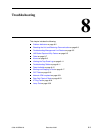
7. Operation and Maintenance
7-44 December 2002 9700-A2-GB20-20
FTP File Transfers
FrameSaver devices support a standard File Transfer Protocol (FTP) server over
Transmission Control Protocol (TCP). To provide backup, a complete binary image
of the configuration files can be copied to a host. To use this feature, the unit must
be configured to support Telnet and FTP Sessions.
Using this feature, you can transfer configuration files to/from
a FrameSaver
node, program files to a FrameSaver node, and User History data from a
FrameSaver node through the user data port (CSU/DSU only) or the network
interface using a management PVC, or through the COM port.
Be aware of the following rules when doing a file transfer:
You must have Access Level 1 permission to use the put and get commands.
However, you can retrieve the data file for user history reports, regardless of
your access level.
You cannot put a configuration file to the factory.cfg or current.cfg files under
the system directory. Configuration files should be put to a customer file
(cust1.cfg or cust2.cfg), then loaded into the downloaded unit’s Current
Configuration via the menu-driven user interface.
You can only put a NAM program file (nam.ocd) into a FrameSaver unit. You
cannot get a program file from the FrameSaver unit to a host.
Before you put a download file, you must use the bin binary command to
place the data connection in binary transfer mode.
When transferring SLV user history information to the NMS, you can only get a
uhbcfull.dat file. It is recommended that you use the NMS application to get
this information (see
Transferring Collected Data
on page 7-48).
A data file (uhbcfull.dat or lmitrace.syc) cannot be put into a FrameSaver
node.
LMI packet capture data (lmitrace.syc) is not readable when the LMI Packet
Capture Utility is active.
The SLV user history file is only available to units with the SLV feature set.
To eliminate operation interruptions, FrameSaver SLV devices provide an
additional feature that allows new software to be downloaded in the background,
using the selected bandwidth and without interfering with normal operation.
Downloads can be performed quickly, using the full line speed, or at a slower rate
over an extended period of time.


















